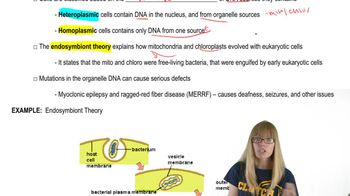Table of contents
- 1. Introduction to Genetics51m
- 2. Mendel's Laws of Inheritance3h 37m
- 3. Extensions to Mendelian Inheritance2h 41m
- 4. Genetic Mapping and Linkage2h 28m
- 5. Genetics of Bacteria and Viruses1h 21m
- 6. Chromosomal Variation1h 48m
- 7. DNA and Chromosome Structure56m
- 8. DNA Replication1h 10m
- 9. Mitosis and Meiosis1h 34m
- 10. Transcription1h 0m
- 11. Translation58m
- 12. Gene Regulation in Prokaryotes1h 19m
- 13. Gene Regulation in Eukaryotes44m
- 14. Genetic Control of Development44m
- 15. Genomes and Genomics1h 50m
- 16. Transposable Elements47m
- 17. Mutation, Repair, and Recombination1h 6m
- 18. Molecular Genetic Tools19m
- 19. Cancer Genetics29m
- 20. Quantitative Genetics1h 26m
- 21. Population Genetics50m
- 22. Evolutionary Genetics29m
7. DNA and Chromosome Structure
DNA as the Genetic Material
Problem 21
Textbook Question
What is the physical state of DNA after it is heated and denatured?
 Verified step by step guidance
Verified step by step guidance1
Understand that DNA is a double-stranded molecule composed of two complementary strands held together by hydrogen bonds between nucleotide bases.
Recognize that heating DNA provides energy to break these hydrogen bonds, causing the two strands to separate, a process known as denaturation.
Acknowledge that after denaturation, the DNA exists as two single strands rather than a double helix.
Note that the single strands are still in a linear form, but they are no longer paired with their complementary strand.
Remember that the physical state of DNA after denaturation is a single-stranded, linear form, which can be re-annealed if cooled slowly under appropriate conditions.
Recommended similar problem, with video answer:
 Verified Solution
Verified SolutionThis video solution was recommended by our tutors as helpful for the problem above
Video duration:
2mPlay a video:
Was this helpful?
Key Concepts
Here are the essential concepts you must grasp in order to answer the question correctly.
DNA Structure
DNA, or deoxyribonucleic acid, is a double helix composed of two strands of nucleotides. Each nucleotide consists of a sugar, a phosphate group, and a nitrogenous base. The strands are held together by hydrogen bonds between complementary bases (adenine with thymine, and cytosine with guanine). Understanding this structure is crucial for comprehending how DNA behaves under different conditions, such as heat.
Recommended video:
Guided course

DNA Structure
Denaturation
Denaturation refers to the process where the double-stranded structure of DNA unravels into two single strands due to the breaking of hydrogen bonds. This typically occurs when DNA is exposed to high temperatures, which disrupts the interactions stabilizing the double helix. Denatured DNA loses its functional properties, making it essential to understand this concept when discussing the effects of heat on DNA.
Physical State of DNA
The physical state of DNA after denaturation is that of single-stranded molecules. In this state, the DNA strands are no longer paired and can exist independently in solution. This change in physical state is significant for various biological processes, including PCR (polymerase chain reaction), where single-stranded DNA serves as a template for replication.
Recommended video:
Guided course

Organelle DNA Characteristics

 9:32m
9:32mWatch next
Master History and Experiments with a bite sized video explanation from Kylia Goodner
Start learningRelated Videos
Related Practice


